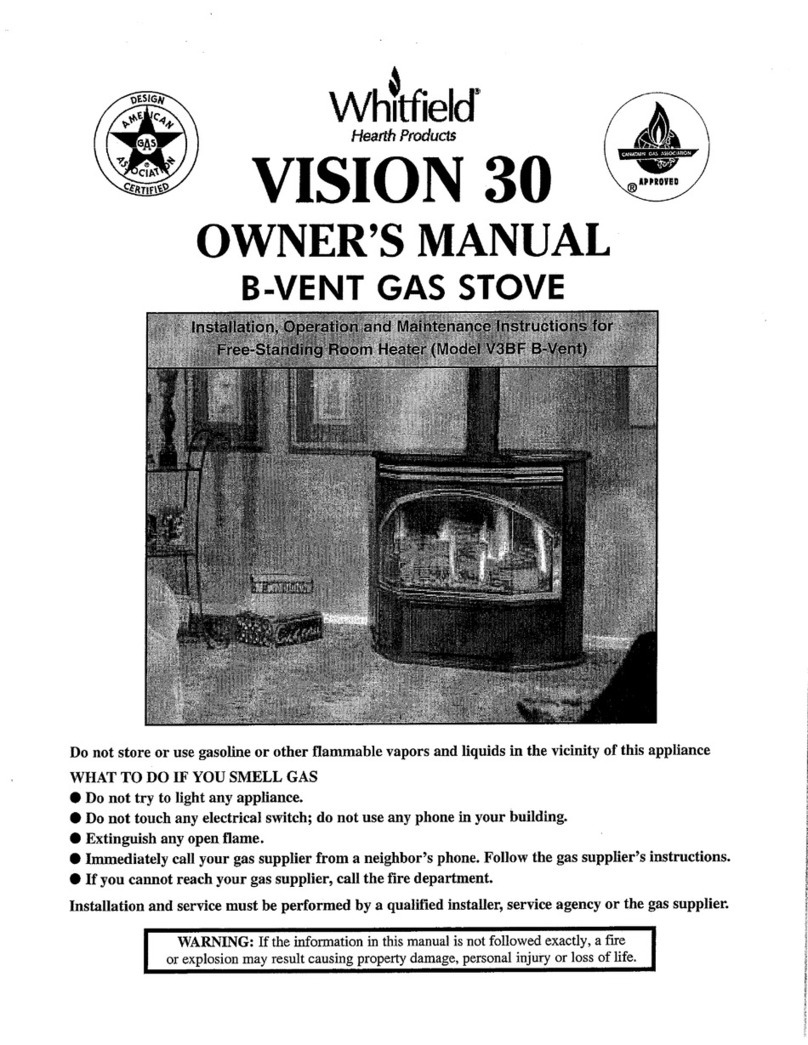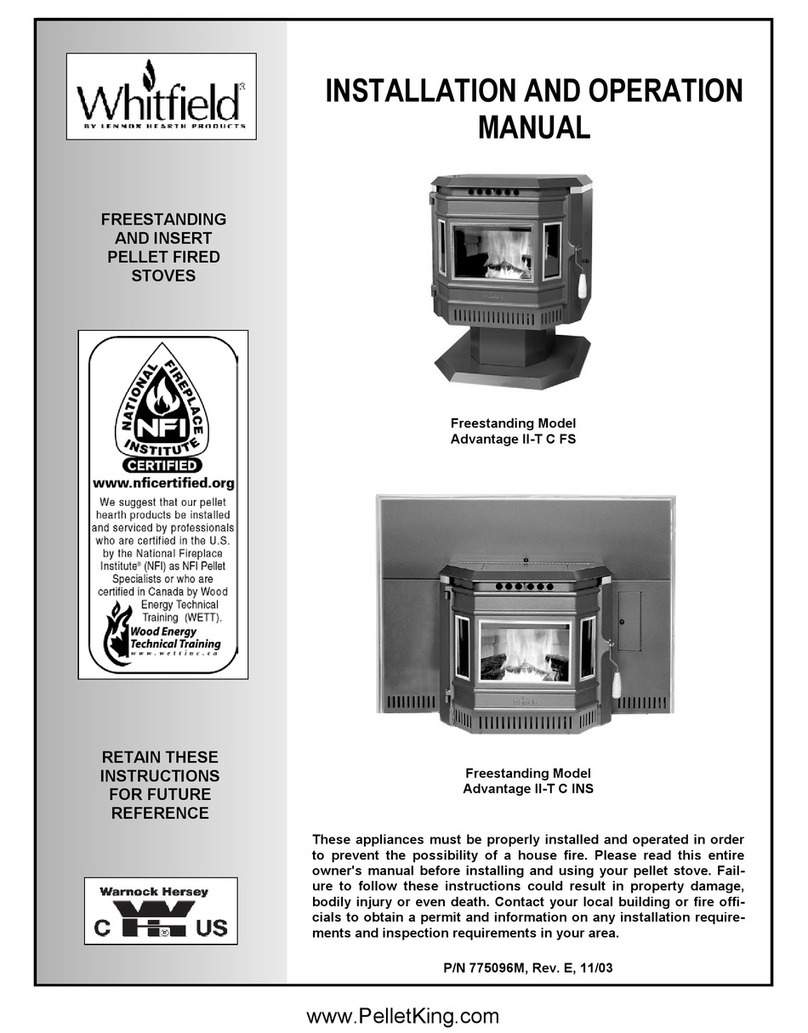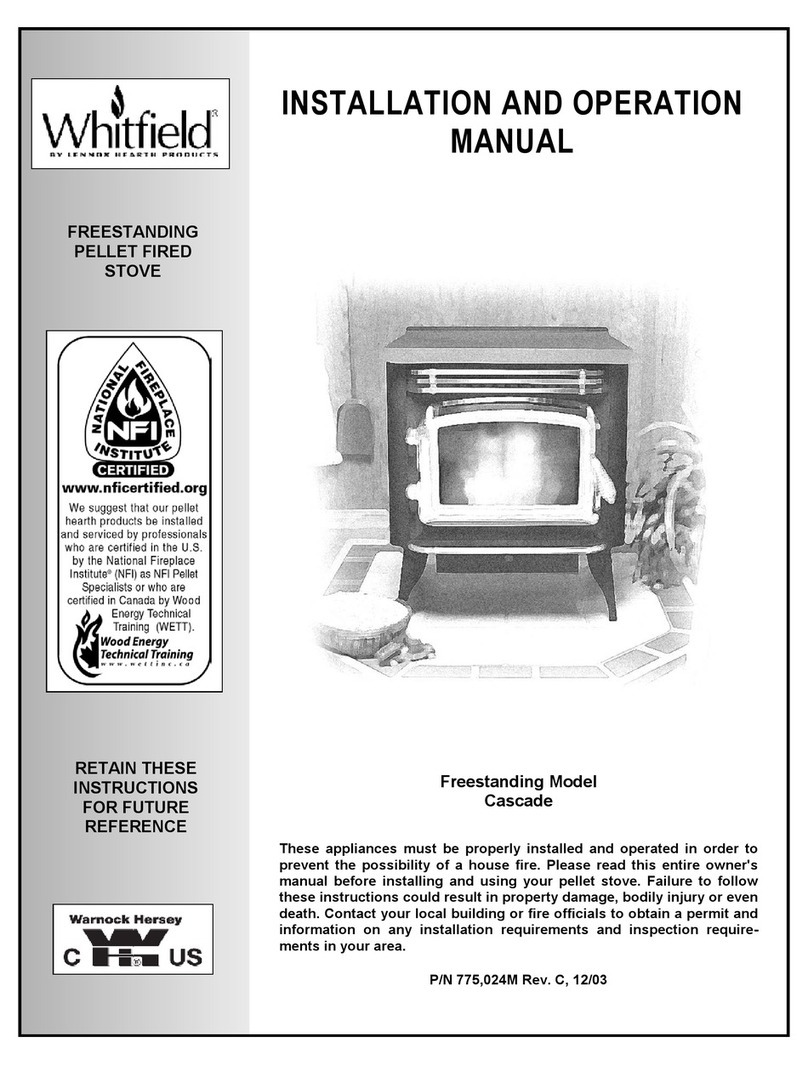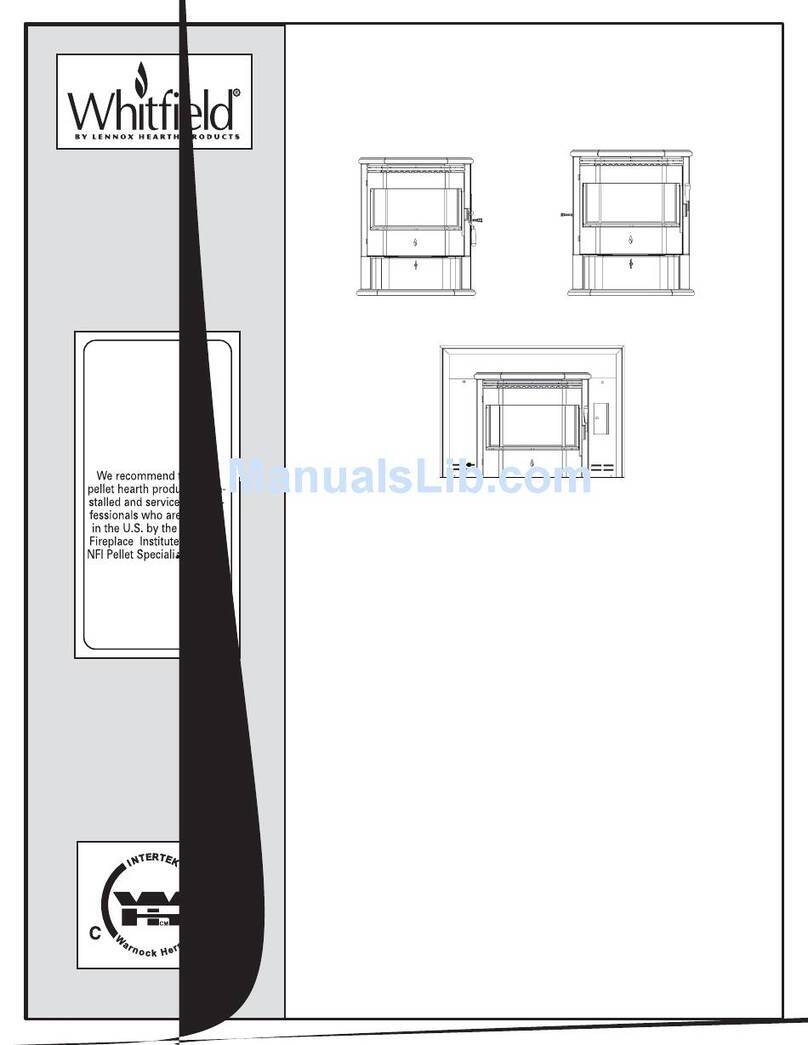
IMPORTANT WARNINGS
CAUTION:
Read this manual thoroughly before starting installation. For your safety, follow the installation, op-
eration and maintenance instructions exactly without deviation. Failure to follow these instructions may result
in a possible fire hazard and will void the warranty. If this appliance is not properly installed, a house fire may
result. Contact local building or fire officials about restrictions and installation inspection in your area.
PAGE 2
1. DO NOT CONNECT THIS UNIT TO A CHIMNEY
FLUE CONNECTED TO ANOTHER APPLIANCE.
2. Do not connect this appliance to air ducts or any air
distribution system.
3. Do not install a flue damper in the exhaust venting
system of this appliance.
4. Do not use class B venting intended for gas appli-
ances as a chimney or connector pipe on a pellet
fired appliance.
5. The minimum clearances must be maintained for all
combustible surfaces and materials including; furni-
ture, carpet, drapes, clothing, wood, papers, etc. Do
not store firewood within this clearance space.
6. INSTALLATION DISCLAIMER - This stoves exhaust
system works with negative combustion chamber
pressure and a slightly positive chimney pressure.
Therefore, it is imperative that the exhaust system be
gas tight and installed correctly. Since Lennox Hearth
Products has no control over the installation of your
stove, Lennox Hearth Products grants no warranty,
implied or stated for the installation or maintenance
of your stove, and assumes no responsibility for any
consequential damage(s).
7. Burning any kind of fuel consumes oxygen. If outside
air is not ducted to the appliance, ensure that there is
an adequate source of fresh air available to the room
where the appliance is installed.
8. This stove is not intended for use in commercial in-
stallations other than where the stove is being sold
without prior approval from Lennox Hearth Products.
9. The stove will not operate using natural draft, nor
without a power source for the blower and fuel feed-
ing systems.
10. Never use gasoline, gasoline-type lantern fuel, kero-
sene, charcoal lighter fluid, or similar liquids to start
or "freshen up" a fire in this heater. Keep all such liq-
uids well away from the heater while it is in use.
11. CONTINUOUS OPERATION: When operated cor-
rectly, this appliance cannot be overfired. Continu-
ous operation at a maximum burn can, however,
shorten the life of the electrical components (blowers,
motors, and electronic controls), and is not recom-
mended. Typical approved operation would include
running at the low to mid range setting with occa-
sional running on the maximum setting during the
coldest periods of the winter. The blower speed con-
trol should be turned to high when operating the
stove on the high heat setting.
12. CAUTION: NEVER PUT FINGERS NEAR AUGER.
Pellet fuel is fed to the UltraGrateby a screw
auger. This auger is driven by a high torque motor.
13. The auger is capable of doing serious harm to fin-
gers. Keep pellets in the hopper at all times and
keep fingers away from auger. The auger can start
and stop automatically at any time while the stove is
running.
14. CAUTION: HOT WHILE IN OPERATION. An appliance
hot enough to warm your home can severely burn any-
one touching it. Keep children, clothing and furniture
away. Contact may cause skin burns. Do not let children
touch the appliance. Train them to stay a safe distance
from the unit.
15. APPROVED FUEL: This appliance is designed specifi-
cally for use only with pelletized wood fuels only. With its
advanced UltraGratetechnology, this appliance is de-
signed and approved for the burning of wood residue
pellets with up to 3% ash content. This appliance is NOT
approved to burn cardboard, nut hulls, cherry pits, corn,
etc. regardless if it is in pellet form. Failure to comply
with this restriction will void all warranties and the safety
listing of the stove. Consult with your authorized Lennox
Hearth Products dealer for more information on ap-
proved pellet fuels and the proper UltraGratefor the
fuels in your area.
16. FLYASH BUILD-UP: For all wood pellet fuel-burning
heaters, the combustion gases will contain small parti-
cles of fly ash. This will vary due to the ash content of
the fuel being burned. Over time, the fly ash will collect
in the exhaust venting system and restrict the flow of the
flue gases. The exhaust venting system should be in-
spected regularly and cleaned as necessary.
17. SOOT FORMATION Incomplete combustion, such as
occurs during startup, shutdown, or incorrect operation
of the room heater will lead to some soot formation
which will collect in the exhaust venting system. A pre-
cautionary inspection on a regular basis is advisable to
determine the necessity of cleaning. The exhaust vent-
ing system should be inspected regularly and cleaned
as necessary.
18. DISPOSING OF ASHES: Any ashes removed from the
pellet stove must be deposited in a metal container with
a tight-fitting lid. The closed container of ashes should
be placed on a noncombustible floor or on the ground,
well away from all combustible materials, outside of the
dwelling pending final disposal. If the ashes are dis-
posed of by burial in soil or otherwise locally dispersed,
they should be retained in the closed container until all
cinders have been thoroughly cooled.
19. SAVE THESE INSTRUCTIONS.
20. See the listing label located on the back of stove (or see
Safety / Listing Labels on pages 45 and 46).
































